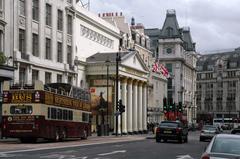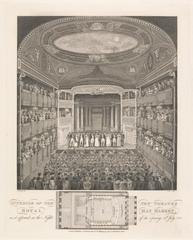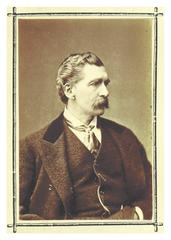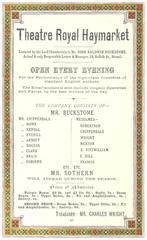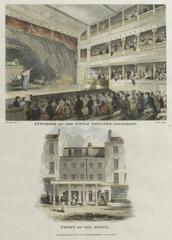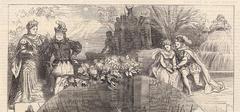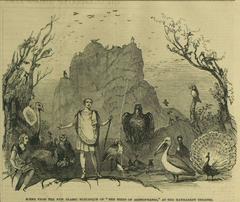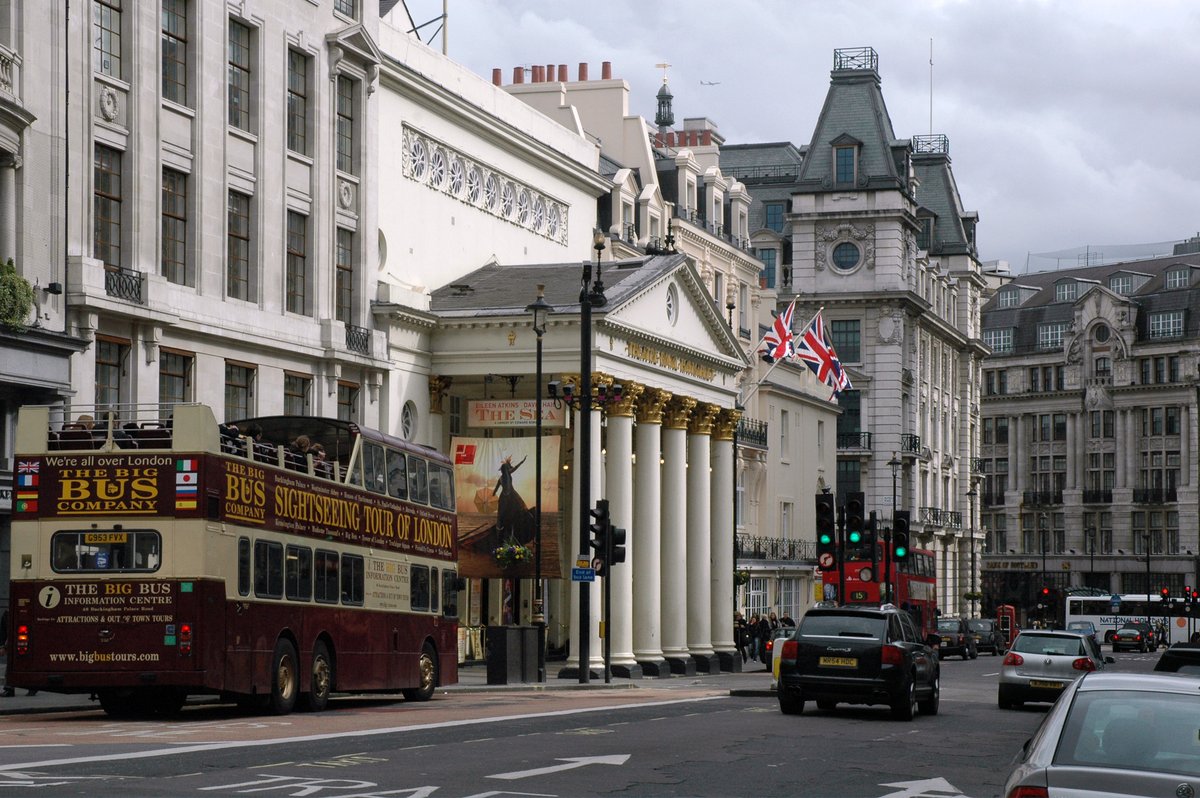
Theatre Royal Haymarket London: Visiting Hours, Tickets, and Historical Significance
Date: 14/06/2025
Introduction
Set in the heart of London’s vibrant West End, the Theatre Royal Haymarket stands as a living testament to the city’s rich cultural and theatrical history. Established in 1720, it is one of the oldest and most distinguished playhouses in continuous operation in the United Kingdom. Over more than three centuries, the Haymarket has played a pivotal role in shaping London’s theatrical landscape, premiering works by legendary playwrights, pioneering performance innovations, and attracting some of the world’s most renowned actors. Its stunning Regency architecture, storied past, and central location near major landmarks make it a must-visit for theatre enthusiasts and tourists alike.
This guide provides everything you need to plan your visit: historical context, visiting hours, ticketing details, accessibility, nearby attractions, and practical tips for a memorable experience. For the latest updates and detailed visitor information, always consult the official Theatre Royal Haymarket website, as well as sources like British History Online and the Folger Shakespeare Library.
Historical Overview
Foundation and Early Years (1720–1766)
The Theatre Royal Haymarket, originally known as the New French Theatre, opened in 1720 on the site of The King’s Head Inn and the Cannon and Musket gunsmith’s shop (British History Online). Built by John Potter, it hosted its first performance—a French play—by a troupe known as The French Comedians of His Grace the Duke of Montague (Wikipedia). By 1730, management shifted to English hands, and the venue became a lively alternative to Covent Garden and Drury Lane theatres.
The Licensing Act and the Royal Patent (1737–1766)
The 1737 Licensing Act restricted legitimate drama to only two theatres, forcing the Haymarket to rely on creative billing, such as “concerts” with free rehearsals. In 1766, a transformative moment arrived when Samuel Foote, after acquiring a lease and suffering a riding accident, was granted a royal patent permitting legitimate drama in summer months (Folger Shakespeare Library). This solidified its status as the Theatre Royal Haymarket, breaking the monopoly of patent theatres and expanding access to Shakespeare and contemporary plays.
Architectural Evolution: John Nash’s Rebuild (1820–1821)
In 1820, famed architect John Nash redesigned the theatre, relocating it further south on Haymarket and giving it its iconic Regency façade with a portico of six Corinthian columns (British History Online). The revamped auditorium improved sightlines and acoustics, features praised to this day (Official London Theatre). The building is now Grade I listed, preserving its architectural and historic value.
Victorian Innovations and Notable Figures
The 19th century saw the Haymarket at the forefront of innovation, staging the West End’s first scheduled matinee in 1873 (Kids Kiddle). Under managers like Benjamin Webster, Squire Bancroft, and Herbert Beerbohm Tree, the theatre became a crucible for new talent and classic drama (SeatPlan).
20th Century and Beyond
The theatre continued to thrive, premiering works by Ibsen and Wilde and hosting stars such as John Gielgud, Judi Dench, Alec Guinness, and more (SeatPlan). A major refurbishment in 1994 modernized the venue, and since then, it has balanced classic revivals with contemporary productions and new writing (Official London Theatre). Recent years have featured acclaimed performances by Bradley Cooper, Ian McKellen, and others (Theatre Tokens).
Visiting Hours
- Box Office: Monday to Saturday, 10:00 AM – 6:00 PM; extended on performance days (Official London Theatre).
- Doors Open: 45 minutes before showtime.
- For Children’s Events: Doors open 30 minutes before showtime.
Always check the official website for the latest visiting hours and performance schedules.
Tickets and Booking Information
- Purchase Options: Online via the official Theatre Royal Haymarket website, by phone, or in person at the box office.
- Pricing: Varies by show and seating location, with premium seats in the Stalls and Royal Circle, and value options in the Upper Circle and Gallery (SeatPlan).
- Discounts: Available for students, seniors, groups, and schools for certain performances.
- Payment: Visa, MasterCard, and American Express accepted. Bars and merchandise counters are cashless.
- Ticket Format: E-tickets are standard; present on your phone or printout.
- Refunds: Tickets are non-refundable and non-exchangeable.
How to Get There
- Address: 18 Haymarket, London SW1Y 4HT
- Nearest Tube: Piccadilly Circus (Bakerloo and Piccadilly lines), Charing Cross (Bakerloo and Northern lines), Leicester Square (Piccadilly and Northern lines) (LoveToVisit)
- Train: London Charing Cross is a 10-minute walk.
- Bus: Multiple routes serve Haymarket; check Transport for London for current routes.
- Car: Located within the Congestion Charging Zone; public transport recommended.
- Taxi: Black cabs are readily available outside the theatre and at Charing Cross.
Accessibility
- Wheelchair Access: Step-free access to the Stalls via Suffolk Place side entrance; accessible toilets available.
- Seating: Designated wheelchair and companion seats (half-price, subject to availability); upper levels accessible by stairs only (SeatPlan).
- Assistance: Contact the box office for specific needs.
- Hearing/Visual Support: Assistance dogs welcome; audio-described performances for selected shows.
- Other Facilities: Large-print programmes and hearing loops available (Official London Theatre).
Nearby Attractions
- Trafalgar Square and the National Gallery
- Piccadilly Circus
- Leicester Square
- St James’s Park
These landmarks are all within a short walk, making it easy to combine your theatre visit with sightseeing (penang-traveltips.com).
Auditorium, Seating, and Amenities
- Capacity: 866 seats (Stalls: 362, Royal Circle: 215, Upper Circle: 186, Gallery: 103) (SeatPlan)
- Best Views: Centre Stalls (Rows E–J), front Royal Circle.
- Value Seats: Sides of Stalls and Royal Circle; restricted view Upper Circle seats.
- Private Boxes: Two exclusive boxes adjacent to the stage.
- Bars: Located on all levels; drinks must be in plastic cups within the auditorium.
- Restrooms: Available on all levels; accessible toilets near the stalls entrance.
Performance Schedule
- Showtimes: Usually evenings at 7:30 PM; matinees at 2:30 PM. Family shows and special events may have different schedules (TRH).
- Running Times: Vary by production; check official listings.
Special Events and Guided Tours
- Guided Tours: Offered occasionally; inquire at the box office or check the official site.
- Special Events: Includes post-show talks, Q&As, and charity galas.
Family and Group Visits
- Age Guidance: Varies per show; check individual event listings.
- Prams/Buggies: Collapsible only, stored in the cloakroom 30 minutes before showtime.
- Group Discounts: Available for groups of 10+ and school bookings (TRH).
Security and Dress Code
- Arrival: Arrive at least 15 minutes before showtime; doors open 45 minutes prior.
- Bag Policy: Only small bags; no storage for large items.
- Dress Code: Smart casual preferred; large hats discouraged (LoveToVisit).
Food and Drink
- Permitted: Cold snacks and drinks in plastic containers.
- Not Permitted: Hot food.
- Cashless: All bars and merchandise counters accept card payments only (TRH).
Photographic Spots
Capture the theatre’s elegant Regency façade and Corinthian columns from Haymarket street, or snap the ornate interior during intervals (photography during performances is strictly prohibited).
Frequently Asked Questions (FAQ)
Q: What are the Theatre Royal Haymarket’s opening hours?
A: Box office is open Monday–Saturday, 10am–6pm; doors open 45 minutes before shows.
Q: How can I buy tickets?
A: Online via the official website, by phone, or in person at the box office.
Q: Is the theatre wheelchair accessible?
A: Yes, step-free access to the Stalls and accessible facilities are available.
Q: Are guided tours available?
A: Occasionally, during special events; check the official website for updates.
Q: Can I take photographs?
A: Photography is allowed in the foyer and auditorium during intervals, but not during performances.
Cultural and Social Impact
The Theatre Royal Haymarket has influenced British theatre traditions, pioneered innovations such as scheduled matinees, and hosted transformative performances that have shaped the city’s artistic landscape. Its central West End location and Grade I listed status cement its place as a cultural landmark (Wikipedia, Kids Kiddle).
Notable Events and Figures
- Samuel Foote: Secured the royal patent for legitimate drama (Folger Shakespeare Library).
- John Nash: Architect of the 1821 Regency rebuild (British History Online).
- Herbert Beerbohm Tree: Influential late 19th-century manager (SeatPlan).
- Modern Stars: Judi Dench, Ian McKellen, Patrick Stewart, Bradley Cooper, and more (Official London Theatre).
Visitor Tips
- Book tickets well in advance, especially for popular productions.
- Arrive early to soak in the architectural detail and secure your seat.
- Use public transport for convenience.
- Contact the box office ahead for accessibility arrangements or group bookings.
- Pre-order interval drinks to avoid queues.
Related Resources
- Official Theatre Royal Haymarket website
- British History Online
- Folger Shakespeare Library
- Official London Theatre
- SeatPlan
- Americana London
- London Theater Tickets
- LoveToVisit
- Penang Travel Tips
Conclusion
Theatre Royal Haymarket is a beacon of London’s theatrical excellence and historical grandeur. With its rich legacy, prime location, and commitment to accessibility, it offers an extraordinary experience for every visitor. For up-to-date information, ticketing, and event schedules, visit the official Theatre Royal Haymarket website.
Enhance your London theatre experience by exploring other historical venues, and download the Audiala app for personalized recommendations, ticket alerts, and exclusive content.
Image suggestions:
- Exterior view of Theatre Royal Haymarket: “Theatre Royal Haymarket facade in London’s West End”
- Interior auditorium photo: “Auditorium seating at Theatre Royal Haymarket”
- Map showing proximity to Trafalgar Square and Leicester Square
References:
